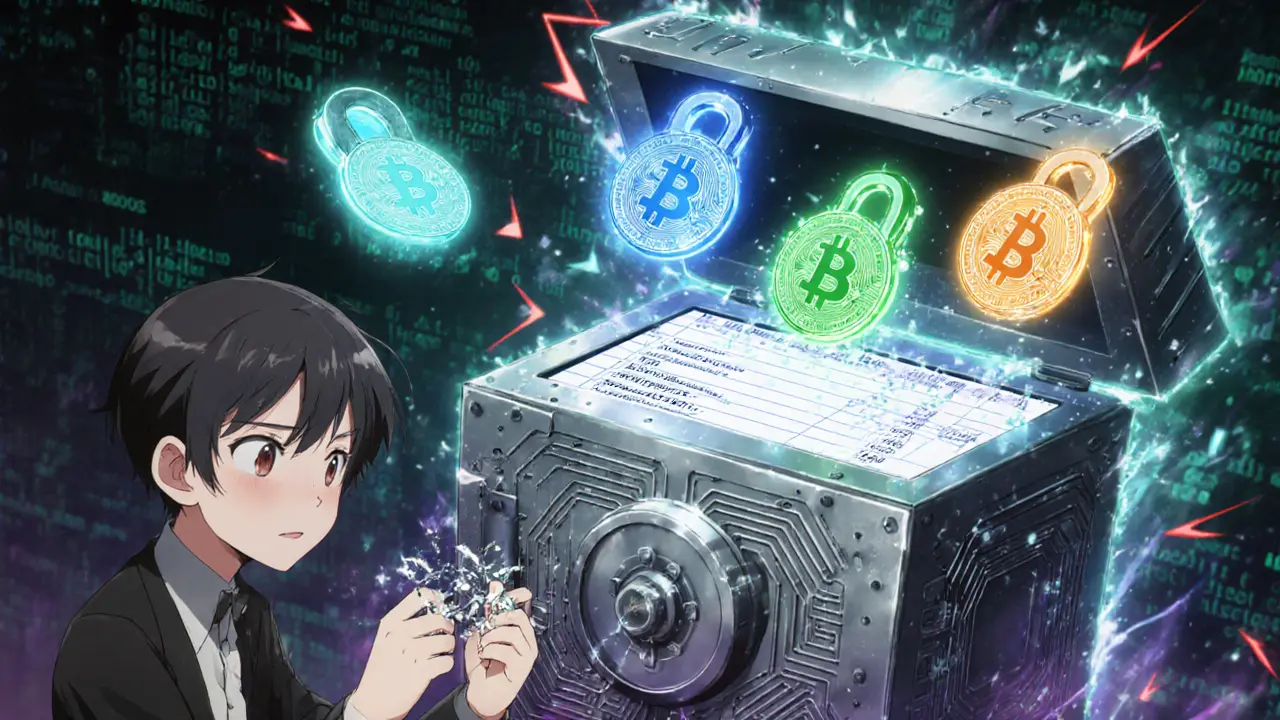Multisig Wallet Configuration Calculator
This tool helps determine the ideal multisig setup based on your security requirements and number of signers.
When you hold large amounts of crypto, a single private key feels like a ticking time bomb. One lost seed phrase or a compromised device can empty your account in seconds. Multisignature wallet is a cryptographic setup that demands two or more private keys before any transaction can leave the blockchain, turning that bomb into a sturdy safe with multiple locks.
Key Takeaways
- Multisig wallets split control across several keys, reducing single‑point‑of‑failure risk.
- Platforms differ in supported blockchains, signer limits, and hardware integration.
- Choosing the right solution hinges on security needs, user experience, and cost tolerance.
- Advanced features like time‑locks and smart‑contract automation are becoming mainstream.
- Proper key management and regular audits remain essential, regardless of platform.
How Multisig Works - A Simple Analogy
Imagine a corporate check that requires three executives to sign before the money moves. In the crypto world, the "executives" are private keys stored on separate devices or with different people. A typical 2‑of‑3 setup means three keys exist, but any two can approve a spend. If one key is lost or stolen, the wallet still functions as long as the remaining keys meet the required threshold.
Behind the scenes, the blockchain records a special script (Bitcoin) or a smart contract (Ethereum) that enforces the rule. When you initiate a transaction, the network holds it until the necessary signatures arrive, then validates them in one block.
Why Institutions Prefer Multisig
Large funds demand accountability. Multisig provides an audit trail-each signature is publicly verifiable, and any change to signers must follow the same consensus rules. This transparency satisfies regulators and internal risk teams alike. Moreover, the distributed nature limits insider threats: a rogue employee can’t move funds alone.
Top Multisig Platforms - Features at a Glance
Below is a snapshot of the most widely adopted solutions as of September2025. The table uses Safe Wallet, Blue Wallet, BitGo, Casa, Electrum, and Coinbase Vault as reference points.
| Platform | Supported Chains | Max Signers | Hardware Wallet Integration | Notable Users | Fee Structure |
|---|---|---|---|---|---|
| Safe Wallet (Gnosis Safe) | Ethereum, Polygon, Arbitrum, Optimism, EVM‑compatible | Up to 50 | Ledger, Trezor, Mobile wallets (MetaMask) | Vitalik Buterin, Aave, Uniswap DAO | Gas‑only; no platform‑level fee |
| Blue Wallet Vault | Bitcoin (mainnet & testnet) | Up to 5 | Ledger, Trezor, Coldcard | Bitcoin Core developers, retail power users | Standard Bitcoin transaction fee + optional service fee |
| BitGo | BTC, ETH, LTC, BCH, XRP, DOGE, many ERC‑20 tokens | Up to 7 | Ledger, Trezor, BitBox02 | Institutional custodians, hedge funds | 1.5% of assets under custody + network fees |
| Casa | Bitcoin, Litecoin | 3-5 (customizable) | Ledger, Trezor, SamsungKnox | High‑net‑worth individuals, family offices | Flat‑rate subscription + transaction fee tier |
| Electrum | Bitcoin, Bitcoin Cash (via plugins) | Up to 15 | Ledger, Trezor, hardware‑wallet‑agnostic (PSBT) | Crypto‑enthusiasts, developers | Free software; only network fees |
| Coinbase Vault | BTC, ETH, USDC, many ERC‑20 tokens | 2-3 | Ledger (via Coinbase app) | Retail users on Coinbase platform | 0.5% of transaction value + network fee |
Each platform follows the same core principle-multiple signatures required-but they diverge on user experience, ecosystem lock‑in, and pricing. Your choice should hinge on three questions:
- Which blockchain(s) do you need to manage?
- How many signers will you realistically involve?
- What level of operational overhead can your team tolerate?
Deep Dive into the Two Dominant Approaches
While most solutions use classic multisig scripts, a rival technology called Multi‑Party Computation (MPC) is gaining traction. MPC never assembles a complete private key in one place; instead, it splits the key into secret shares and performs cryptographic operations jointly. This design eliminates the “one key lost” scenario entirely, but it adds protocol‑level complexity and often requires proprietary infrastructure.
For most organizations, the proven track record of on‑chain multisig outweighs MPC’s novelty. Yet, if you’re building a decentralized finance (DeFi) product that demands seamless keyless user flows, exploring MPC‑based custodians (e.g., Fireblocks, Curv) is worthwhile.

Security Checklist - What to Verify Before Going Live
- Audit status: Ensure the wallet’s smart contract or script has been audited by a reputable firm (e.g., OpenZeppelin, ConsenSys Diligence).
- Signer diversity: Avoid storing all keys on the same type of device; mix hardware wallets, air‑gapped machines, and possibly a mobile signer.
- Recovery plan: Document who can replace a lost signer, what thresholds apply, and how to execute a “key rotation” without exposing funds.
- Time‑lock features: Consider CLTV or CSV scripts that prevent a transaction from being executed before a set date, adding an extra safety net.
- Operational testing: Run a “dry‑run” with a small amount-initiate a transaction, collect the required signatures, and confirm the broadcast works as expected.
Real‑World Use Cases
Institutional treasury: A hedge fund managing $500M in BTC uses BitGo’s 3‑of‑5 setup, with two senior partners, the compliance officer, and a cold‑storage enclave as signers. The multi‑sign rule satisfies internal controls and regulator‑mandated separation of duties.
DeFi DAO: A DAO governing a $200M liquidity pool on Ethereum relies on Safe Wallet’s “module” system to automate weekly payouts, requiring a 2‑of‑4 signature for any change in payout schedule. The module reduces manual overhead while preserving security.
Family office: A family with three generations uses Casa’s 3‑of‑5 vault. Each generation controls one key, and two backup keys reside in a hardware‑secure module at a trusted law firm. If a member passes away, the remaining keys still meet the threshold.
Future Trends - What’s Coming After 2025
Cross‑chain multisig bridges are entering beta: platforms aim to let a single multisig policy govern assets on Bitcoin, Ethereum, and Solana simultaneously. Expect more UI‑driven sign‑off flows, biometric‑plus‑hardware combos, and AI‑assisted anomaly detection that flags unusual transaction patterns before signatures are collected.
Regulators are also drafting guidelines that treat multisig wallets as “shared custodial accounts.” This could mean new compliance reporting requirements for large‑scale multisig deployments, making audit‑ready platforms (like BitGo) even more attractive.
Choosing the Right Platform - Decision Tree
- If you need Ethereum‑centric DeFi integration → Safe Wallet.
- If you focus solely on Bitcoin and want a mobile‑first approach → Blue Wallet Vault.
- If you run a regulated institution with multiple asset classes → BitGo (custodial plus multisig).
- If you prefer a light‑weight desktop client with open‑source code → Electrum.
- If you want a simple retail experience tied to an exchange → Coinbase Vault.
Remember, the platform is just the front‑end. Your security posture comes from how you manage the keys, how you train signers, and how you document recovery procedures.
Frequently Asked Questions
What is the difference between a 2‑of‑3 and a 3‑of‑5 multisig wallet?
A 2‑of‑3 setup needs any two of the three keys to sign, offering faster approvals but slightly lower resistance to a single key loss. A 3‑of‑5 requires three out of five, providing higher fault tolerance (you can lose up to two keys) at the cost of more coordination.
Can I add or remove signers after the wallet is created?
Yes, most platforms let you rotate keys. With Safe Wallet you use a "module" to propose signer changes, which then follow the same multisig rule. Some Bitcoin scripts require a fresh transaction to replace the script, so plan signer changes ahead of time.
Do multisig wallets increase transaction fees?
Yes, because the transaction carries larger scripts or smart‑contract data. On Bitcoin a 2‑of‑3 P2WSH script adds ~250 bytes, while on Ethereum the Safe Wallet adds a small amount of gas for the contract call. The extra cost is usually a few cents to a dollar, depending on network congestion.
Is it safe to store one of my keys in a cloud‑based wallet?
Only if the cloud provider implements strong hardware‑based isolation and you treat that key as a low‑risk signer (e.g., a monitoring key that can only approve withdrawals below a threshold). Most security best practices advise keeping at least one key offline.
How does Multi‑Party Computation compare to classic multisig?
MPC splits the private key into secret shares and performs signing without ever reconstructing the full key. It removes the "key loss" risk but relies on proprietary protocols and often higher service fees. Classic multisig is open‑source, works directly on-chain, and is audited by the community, making it the go‑to for most institutions today.
Getting Started - A Quick 5‑Step Setup
- Pick a platform: For Ethereum assets, create a Safe Wallet. For Bitcoin, download Blue Wallet and enable the Vault feature.
- Generate signers: Use a hardware wallet (e.g., Ledger NanoX) for at least two signers. For the third, consider an air‑gapped laptop with a fresh seed phrase.
- Define the threshold: Choose 2‑of‑3 for faster moves, 3‑of‑5 if you want extra redundancy.
- Test with a tiny amount: Send 0.001BTC or 0.005ETH, collect signatures, and verify the transaction appears on the blockchain.
- Document the process: Write a SOP covering signer responsibilities, recovery steps, and who can rotate keys in the future.
Follow these steps and you’ll have a production‑ready multisig wallet in under an hour.

Bottom Line
If you’re guarding anything beyond a hobbyist stash, a multisig wallet is no longer optional-it’s the baseline for responsible crypto custody. Pick a platform that aligns with your chain mix, signer count, and budget, and then lock down the operational details. With the right setup, you’ll sleep better knowing your assets can’t be moved by a single compromised device.







Comments
Waynne Kilian
October 1, 2025 AT 02:10 AMI think the article does a great job of breaking down the basics of multisig, but there's always room to reflect on how human trust factors into key distribution. When you spread keys across family members, you also spread the emotional weight of responsibility. It reminds me of a communal potluck where everyone brings a dish, and if one forgets, the whole spread suffers. In the end, the technology is only as strong as the relationships behind it.
Naomi Snelling
October 2, 2025 AT 05:56 AMSure, multisig sounds safe, but who’s really watching the watchers? Every platform you trust could be a front for data siphoning, especially when they claim "audit‑ready" without disclosing the auditors. And the fact that they hide fee structures in fine print? Classic red flag. Stay vigilant, question every layer of abstraction, and consider the possibility that the entire ecosystem is a curated illusion.
Michael Wilkinson
October 3, 2025 AT 09:43 AMListen, you can't afford to be lax with thresholds. If you set a 2‑of‑3 for a high‑value vault, you’re basically inviting anyone with one compromised device to hijack half the signatures. Tighten that to at least 3‑of‑5 for anything over $100k, and make sure every signer has a hardware wallet locked away. The risk of a single point of failure is unacceptable in a hostile environment.
Billy Krzemien
October 4, 2025 AT 13:30 PMGreat point on tightening thresholds, Michael. In practice, pairing hardware wallets with an air‑gapped signer adds a robust layer of defense. I’ve seen teams implement a 3‑of‑5 policy where two signatures come from Ledger devices, one from a sealed cold‑card, and the remaining two are distributed to senior officers. This configuration balances security with operational feasibility, and the audit logs remain clear and immutable.
april harper
October 5, 2025 AT 17:16 PMAh, the poetic dance of keys and trust! One might imagine a vault guarded by silent sentinels, each waiting for the other to whisper approval.
Clint Barnett
October 6, 2025 AT 21:03 PMWhen you dive into the world of multisig, you quickly realize that it is not merely a technical construct but a narrative tapestry woven from threads of human intent, cryptographic rigor, and organizational choreography. Imagine, if you will, a symphony orchestra where each musician holds a distinct instrument-some strings, some brass, some percussions-and the conductor must secure a harmonious convergence before the final note resounds. In the realm of crypto, each instrument is a private key, and the conductor is the transaction awaiting the requisite signatures. The first movement begins with the selection of a platform, a decision that hinges upon the supported chains, the ease of integration, and the fee structure, much like choosing the right hall for a performance. Next, you must orchestrate the distribution of signers, ensuring that no single voice dominates the melody; this is the essence of decentralization, a principle that fosters resilience against both external adversaries and internal collusion.
Consider the instrumentation: hardware wallets such as Ledger or Trezor lend a tactile certainty, air‑gapped laptops provide an ethereal layer of isolation, and mobile signers add a dash of convenience. When these elements converge, the resulting multisig script resembles a complex chord-rich, layered, and resistant to being muted by a single dissonant note. Yet, as any seasoned composer knows, complexity must be balanced with clarity. Over‑complicating the threshold-say, a 10‑of‑12 setup for a modest portfolio-introduces logistical friction that can erode operational efficiency.
The next phrase in this composition is the governance model. Who are the custodians of each key? How are they vetted? Are there rotating policies that mimic the shifting seasons? A well‑crafted governance framework ensures that the symphony can continue even if a musician steps away, allowing for seamless key rotation without compromising the harmony.
From a security perspective, the inclusion of time‑lock scripts adds a temporal cadence; transactions cannot be executed before a predetermined epoch, granting a reflexive safety net. Pair this with rigorous audits-preferably by independent firms like OpenZeppelin or ConsenSys Diligence-and you compose a piece that not only sounds beautiful but also withstands the test of scrutiny.
In the modern fintech arena, the audience is not merely passive; regulators are becoming active members of the orchestra, demanding transparency and compliance. Platforms that provide audit‑ready logs are akin to musicians publishing their sheet music, inviting scrutiny and fostering trust.
Finally, the crescendo arrives when real‑world testing is performed. A dry‑run with a minuscule amount of crypto serves as a rehearsal, ensuring every participant knows their cues, every signature aligns, and the transaction finally broadcasts flawlessly to the blockchain.
In summary, the art of multisig is a delicate balance between technical depth and human orchestration. Choose your platform wisely, distribute your keys thoughtfully, embed governance and time‑locks, and rehearse diligently. The result is a resilient, harmonious vault that safeguards assets while allowing the music of decentralized finance to play on.
Jacob Anderson
October 8, 2025 AT 00:50 AMOh sure, because adding another “smart‑contract” layer magically turns a sloppy key management process into Fort Knox. Congrats on finding a way to make the UI look pretty while still leaving the same old single‑point‑of‑failure lurking underneath. Maybe next you’ll suggest adding glitter to the backup phrase.
Kate Nicholls
October 9, 2025 AT 04:36 AMThe article does a solid job of outlining the landscape, but it glosses over the fact that many of these platforms charge hidden fees that can erode returns over time. Practitioners should scrutinize not just the on‑chain costs but also the subscription models and any ancillary service charges. A thorough cost‑benefit analysis is essential before committing to any solution.
Carl Robertson
October 10, 2025 AT 08:23 AMAlright, let’s dramatize the scenario: a lone developer, bathed in the cold glow of a monitor, watches the blockchain as if it were a looming abyss. He contemplates the tragedy of a single‑key loss, then breathes in the bittersweet relief of a 3‑of‑5 vault. Yet, the drama isn’t over-every signature request feels like a silent scream in an empty hall.
Rajini N
October 11, 2025 AT 12:10 PMFor anyone feeling a bit lost, here’s a quick checklist: 1) Pick your platform based on the chains you need. 2) Generate hardware keys-Ledger or Trezor are solid choices. 3) Decide on your threshold; 2‑of‑3 works for most personal use, 3‑of‑5 for families or small teams. 4) Do a tiny test transfer, collect the signatures, and confirm the transaction lands. 5) Document the SOP, including who can rotate keys and how. Following these steps saves a lot of headaches later.
Lindsay Miller
October 12, 2025 AT 15:56 PMI appreciate the thorough guide. It’s clear and helpful for beginners. The steps are easy to follow, and the safety tips are spot on.
Katrinka Scribner
October 13, 2025 AT 19:43 PMThanks for the guide! It really helped me get started with multisig 😃 I was a bit nervous at first, but the step‑by‑step demo made it simple. Looking forward to protecting my assets better! 🙌
VICKIE MALBRUE
October 14, 2025 AT 23:30 PMGreat resource!
Kate Roberge
October 16, 2025 AT 03:16 AMHonestly, I think the whole multisig hype is overblown. You can just keep your keys in a safe and call it a day. Adding these platforms just adds unnecessary layers of bureaucracy.
Oreoluwa Towoju
October 17, 2025 AT 07:03 AMWhat about the latency in receiving signatures across different time zones? Is there a recommended window for transaction approval?
Jason Brittin
October 18, 2025 AT 10:50 AMOh yeah, because waiting for a coworker in another continent to sign is just *so* thrilling 😏. Maybe set up a coffee break for the signature party?
Amie Wilensky
October 19, 2025 AT 14:36 PMReally-this article-covers everything, from basics to advanced setups; however, it still lacks a deep dive into the nuances of hardware wallet firmware updates and their impact on key integrity across multi‑signature schemas - a crucial omission for practitioners seeking comprehensive guidance.